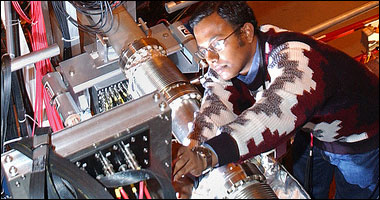




Why Does Quark Matter 'Matter'?
The history of modern technological development can be viewed as a series of investigations, with ever increasing resolution, into the microscopic structure of matter. Since the days of the early Greek philosophers, science has been on a continual quest to find the smallest piece — the most fundamental building block — forming the substance of the universe.

During that journey, many beautiful and exotic properties of the subatomic world have been discovered: particles with wave-like properties the ultimate position of which can never be known; “particles” of light that deliver a fixed amount of energy when they strike the atoms of a material’s surface; particles in some types of electrical conductors that pair in a unique way because of intrinsic “spin” so that, below a certain temperature, all resistance goes to zero.
Knowledge of these and many other properties discovered in the last century in the process of studying matter at ever smaller scales lets us use matter and energy in ways too fantastic to imagine just 50 years ago.
Today's technology relies on a basic understanding of the structure and properties of matter. School children work on personal computers based upon state-of-the-art electronics. Diseases are imaged, diagnosed, and treated without surgery. And people can speak clearly to others around the world using a phone smaller than a human hand.
RHIC is designed to extend this frontier, providing access to the most fundamental building blocks of nature known so far — quarks and gluons. By colliding the nuclei of gold atoms together at nearly the speed of light, RHIC heats the matter in collision to more than a billion times the temperature of the sun. In so doing, scientists are able to study the fundamental properties of the basic building blocks of matter and learn how they behaved 15 to 20 billion years ago, when the universe was barely a split-second old.
Scientists have a theory, called quantum-chromo dynamics, about what will be revealed at RHIC. However, without performing the experiment, who knows what the truth really is?
Many of the greatest advances of the last century resulted from experiments that produced results completely different from what theory predicted. Those successful “failures” led to a new understanding of the microscopic structure of matter and to technologies essential to modern life.
RHIC provides the first chance for a rigorous test of the most basic predictions of what is thought to be understood about the structure of matter at the smallest scale imagined. However, it's impossible to predict what RHIC will provide in terms of technology for the future. Because RHIC is pushing further out on the high-temperature frontier than ever before, any new understanding about the structure of matter arising from RHIC may not immediately or ever lead to practical applications as did experiments in the last century.
If history is any indicator, two things are clear: First, humankind can only profit by having a deeper, more profound understanding of the ultimate structure of the matter making up the universe. And second, every time that something fundamental has been learned about the matter’s structure at a deeper level that knowledge has resulted in a benefit to humankind.
